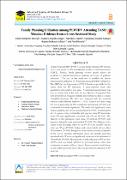| dc.description.abstract | People living with HIV (PLWHIV) need family planning (FP) services to avert the spread of HIV and eliminate mother to child transmission (MTCT). Besides, family planning services greatly reduce the incidence of vertical transmission reducing new cases of pediatric infections. The aim of this study was to establish the factors influencing the utilization of FP services among PLWHIV affiliated to The AIDS Service Organization (TASO) Masaka responsible for the unmet need for FP utilization. A cross-sectional study with quantitative data analysis was used. A structured questionnaire was used to collect data in line with the set objectives. Categorical data were presented as frequency percent and continuous data as a mean ±standard deviation. The data were analyzed with the statistical software called Medcalc software v. 19.5.6. Analysis was done using the test of proportion at 95% confidence interval and a P<0.05 was considered statistically significant. The study had significantly more females, married, and of low education level (p<0.05). Medium parity of 1-3, a spouse being comfortable with a partner using FP, knowledge about FP were significantly associated with FP use (P<0.05). The Majority of the participants were using FP methods (P<0.05) with injections being the most used method (P<0.05). The Majority of the clients would encourage others to use FP (P<0.05) and HIV had no effect on FP use (P<0.05). Culture and society beliefs did not affect FP utilization (P<0.05). Being close to the service provider, hospitality of the service provider, information about the benefits and risks associated with FP use were significantly associated with utilization of FP methods (P<0.05). However, the overall utilization of FP was low (58.9%) and was largely affected by personal factors other than community or service delivery factors. Future research should focus on the putative personal factors that may prevent the utilization of FP methods. | en_US |

